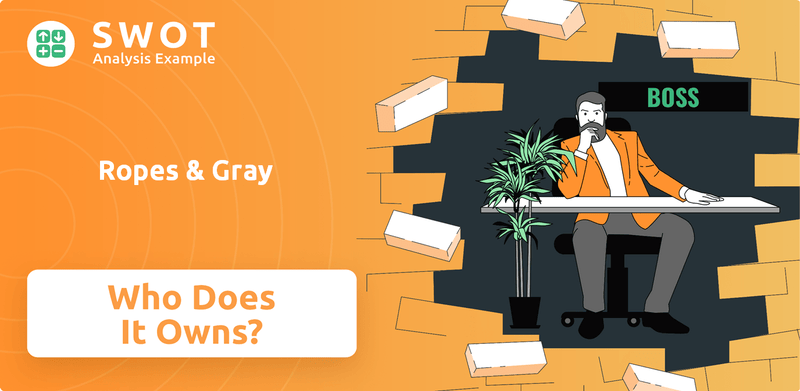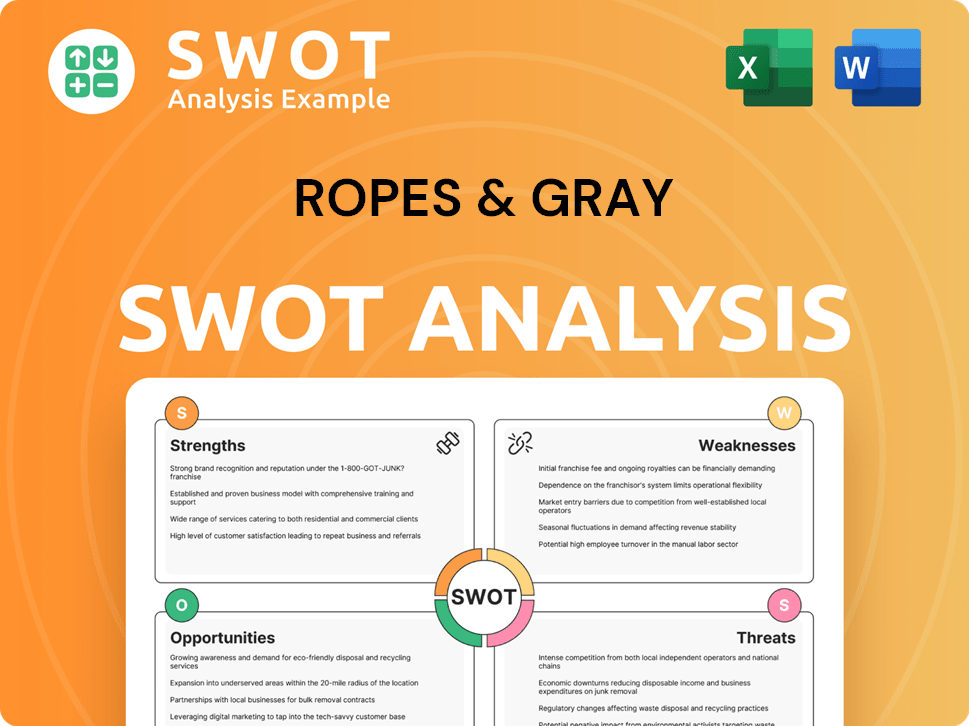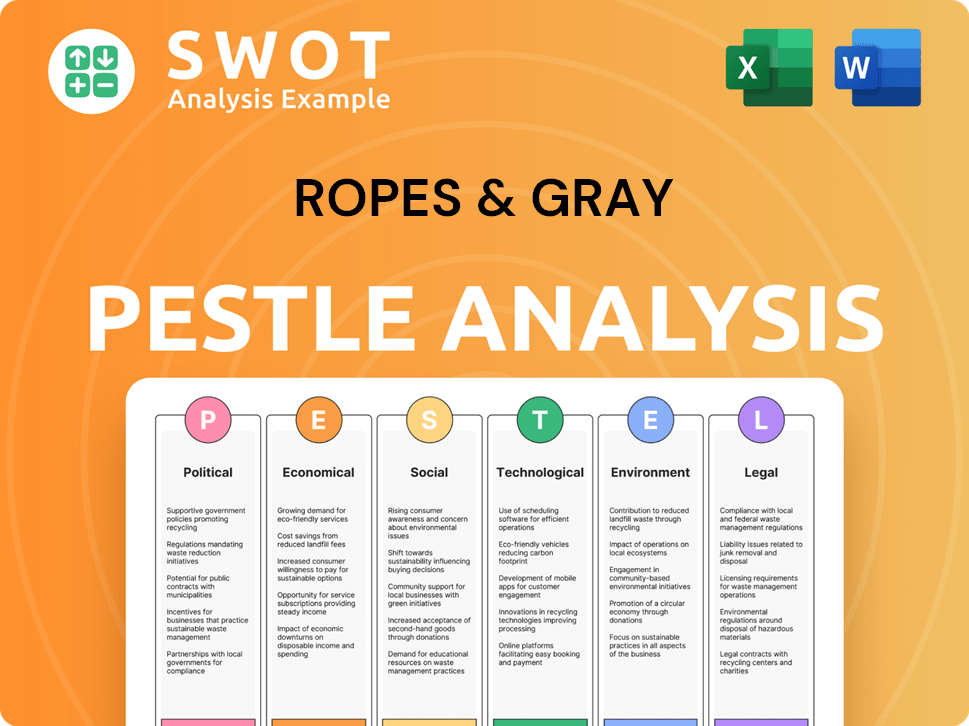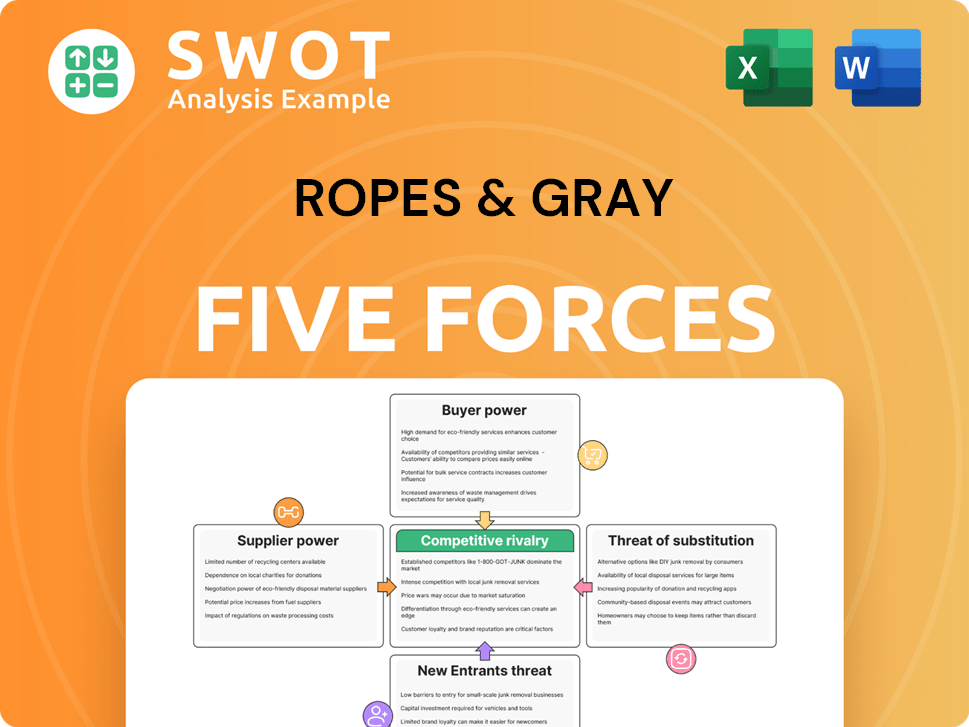Ropes & Gray Bundle
Who Truly Controls Ropes & Gray?
Understanding the ownership of a company is crucial for grasping its strategic direction and operational philosophy. For a legal powerhouse like Ropes & Gray, this understanding is even more critical. This exploration dives deep into the Ropes & Gray SWOT Analysis, revealing the intricacies of its ownership structure, from its founding in 1865 to its current status as a global leader in the legal field.

As a prominent player in the legal landscape, knowing who owns Ropes & Gray offers invaluable insights for investors, business strategists, and anyone interested in the firm's future. This analysis will uncover the details of Ropes & Gray ownership, examining its partnership model and how it influences the firm's decisions and its commitment to clients. This deep dive into Ropes & Gray law firm ownership will reveal its unique position in the legal industry.
Who Founded Ropes & Gray?
The origins of Ropes & Gray trace back to 1865, when it was established as a partnership in Boston. The founders, John Codman Ropes and John Chipman Gray, both alumni of Harvard Law School, set the foundation for what would become a prominent law firm. The early focus was on serving individuals and a select group of companies, including Harvard University.
The firm's structure and ownership model were intrinsically linked to its partnership status. This meant that the founding partners initially held direct ownership, with profits and control distributed among them. Over time, the firm's evolution included name changes as partners joined and departed, reflecting its growth and adaptation to changing legal landscapes.
The firm's early history, marked by its commitment to high standards and client service, laid the groundwork for its future success. This commitment to quality and ethical practice was a key element in shaping its reputation. The firm's transition from serving primarily individuals to focusing on corporations, such as the New York and New England Railroad, highlights its adaptability.
Ropes & Gray's early structure was a partnership, meaning ownership and control were vested in the partners. The firm's evolution saw changes in its name reflecting the addition and departure of partners. The firm's focus on building a reputation for "first-rate work, a positive outlook, and the highest standards of service and ethics" was crucial.
- The firm's initial focus was on serving individuals and a few companies.
- As the firm grew, it shifted its focus to corporate clients.
- The partnership structure meant that control and profits were distributed among the partners.
- The firm's early history reflects its commitment to high standards of service.
Ropes & Gray SWOT Analysis
- Complete SWOT Breakdown
- Fully Customizable
- Editable in Excel & Word
- Professional Formatting
- Investor-Ready Format

How Has Ropes & Gray’s Ownership Changed Over Time?
As a limited liability partnership (LLP), Ropes & Gray's ownership resides with its partners, not external shareholders. This structure places the firm's equity partners as the primary stakeholders. The firm's financial performance reflects this ownership model, with revenue reaching $2.992 billion in 2023 and $2.9 billion in 2024, a considerable increase from $1.9 billion in 2020. The profit per equity partner was approximately $4.5 million, highlighting the substantial financial stake the partners hold.
Key events have shaped the firm's ownership. Strategic acquisitions, such as the 2003 acquisition of Reboul, MacMurray, Hewitt & Maynard and the 2005 acquisition of Fish & Neave, expanded practice areas and geographic reach. These acquisitions directly impacted the ownership structure by integrating new partners. The firm's expansion to over 1,500 lawyers and professionals across 14 offices further demonstrates its growth. Leadership figures, including Chair Julie Jones and Managing Partner David Djaha, are key equity partners guiding the firm's strategy. The firm's focus on private equity, asset management, and healthcare and life sciences has driven success and influenced strategic investments and partner development.
| Metric | 2020 | 2023 | 2024 |
|---|---|---|---|
| Revenue (Billions) | $1.9 | $2.992 | $2.9 |
| Profit per Equity Partner (Approximate) | N/A | $4.5 million | N/A |
| Number of Lawyers and Professionals | N/A | Over 1,500 | N/A |
Understanding Ropes & Gray ownership is crucial for grasping its operational dynamics. The firm's structure as a partnership influences decision-making and strategic direction. Its growth trajectory, as discussed in Growth Strategy of Ropes & Gray, is closely tied to its ownership model and strategic acquisitions. Key figures like Julie Jones and David Djaha, as equity partners, play pivotal roles in shaping the firm's future. The firm's focus on key sectors like private equity has significantly influenced its investments and partner development, reflecting the interests of its ownership.
Ropes & Gray ownership is structured around its partners, with no public shareholders. The firm's revenue has shown substantial growth, reaching nearly $3 billion in 2023. Key leaders like Julie Jones and David Djaha are equity partners, guiding the firm's strategy.
- The firm's ownership structure is a limited liability partnership (LLP).
- Revenue has increased significantly in recent years, reflecting strong financial performance.
- Strategic acquisitions have expanded the firm's practice areas and geographic reach.
- The firm's focus on private equity and other key sectors drives its success.
Ropes & Gray PESTLE Analysis
- Covers All 6 PESTLE Categories
- No Research Needed – Save Hours of Work
- Built by Experts, Trusted by Consultants
- Instant Download, Ready to Use
- 100% Editable, Fully Customizable

Who Sits on Ropes & Gray’s Board?
As a limited liability partnership, the structure of Ropes & Gray differs from that of a publicly traded corporation. Instead of a traditional board of directors, the firm's governance is managed internally through its partnership structure. Key leadership roles, such as Chair and Managing Partner, along with a management committee, hold significant influence in decision-making processes. These individuals, typically senior partners, are central to strategic planning and operational oversight.
Currently, Julie Jones serves as the Chair of Ropes & Gray, having been re-elected for a second five-year term in September 2024. David Djaha, the Managing Partner, is set to retire in 2025, completing his five-year term in December 2024. Neill Jakobe has been appointed Vice Chair for a five-year term beginning in January 2025 and is a member of the firm's management committee. The firm's leadership structure ensures that experienced partners guide the firm's direction, including decisions on partner promotions, compensation, and overall firm strategy. Understanding the firm's structure is crucial for anyone looking into Ropes & Gray ownership.
| Leadership Role | Name | Term Details |
|---|---|---|
| Chair | Julie Jones | Re-elected September 2024, second five-year term |
| Managing Partner | David Djaha | Retiring in 2025, completing his five-year term in December 2024 |
| Vice Chair | Neill Jakobe | Five-year term beginning January 2025 |
The voting power within Ropes & Gray, as a law firm partnership, generally follows a 'one-partner, one-vote' principle, or a system based on equity stake or seniority, although the precise details are internal. The firm's commitment to maintaining a specific workplace culture is evident in its policies. The firm's approach to growth and strategy is explored in detail in the article Growth Strategy of Ropes & Gray, providing additional insights into its operational and strategic decisions. This internal governance structure is key to understanding who owns Ropes & Gray and how it operates within the legal industry.
Ropes & Gray is managed by a partnership structure, not a traditional board of directors.
- Julie Jones currently serves as Chair, re-elected in September 2024.
- David Djaha is the Managing Partner, retiring in 2025.
- Neill Jakobe will serve as Vice Chair, starting January 2025.
- Voting power is typically based on a 'one-partner, one-vote' system.
Ropes & Gray Business Model Canvas
- Complete 9-Block Business Model Canvas
- Effortlessly Communicate Your Business Strategy
- Investor-Ready BMC Format
- 100% Editable and Customizable
- Clear and Structured Layout

What Recent Changes Have Shaped Ropes & Gray’s Ownership Landscape?
In the past few years, Ropes & Gray has demonstrated significant growth and strategic shifts, reflecting broader trends in the legal industry. The firm's revenue reached $2.9 billion in 2024, a substantial increase from $1.9 billion in 2020. This growth underscores the firm's success in a competitive market. The firm's expansion includes opening an office in Paris in early 2025, bringing its total number of offices to 15, and launching an office in Singapore in July 2023.
Regarding ownership, Ropes & Gray operates as a private partnership, which means it is not subject to the same institutional ownership trends seen in publicly traded legal service providers. The firm's financial performance is strong, with approximately $4.5 million in profit per equity partner. This financial success highlights the value and returns for its partners within the firm. The firm continues to advise on major transactions, such as guiding Pfizer in several significant M&A deals and advising on the sale of Signify Health to CVS Health for $8.1 billion.
Leadership changes also reflect the firm's commitment to succession planning. Julie Jones was re-elected as Chair for a second five-year term in September 2024, and Neill Jakobe was appointed Vice Chair starting January 2025. David Djaha, the current Managing Partner, is retiring in December 2024. These transitions ensure continuity and strategic direction within the firm's partnership structure. The firm's focus on high-value practice areas and global expansion demonstrates its adaptability to industry trends and its commitment to maintaining a leading market position. The firm promoted 12 new partners in 2024, indicating investment in its core strengths.
Ropes & Gray operates as a private partnership. This structure means that the firm is owned and managed by its partners, who share in the profits and bear the financial responsibilities of the firm. The firm's ownership is not publicly traded, which is a key characteristic of its legal company structure.
The firm has a strong presence in the private equity law firm sector, advising on numerous significant deals. Its expertise in private equity is a key driver of its financial success. The firm's launch of an office in Singapore in July 2023 supports its growing private equity practice in Southeast Asia.
Ropes & Gray is owned by its partners. These partners are senior lawyers who have been promoted within the firm. The firm's ownership structure is a key aspect of its identity. It influences its strategic decisions and financial performance.
Ropes & Gray's revenue reached $2.9 billion in 2024. The firm's profit per equity partner is approximately $4.5 million. These figures highlight the firm's financial success and its strong position in the legal market. The increase in revenue from $1.9 billion in 2020 shows the firm's growth.
Ropes & Gray Porter's Five Forces Analysis
- Covers All 5 Competitive Forces in Detail
- Structured for Consultants, Students, and Founders
- 100% Editable in Microsoft Word & Excel
- Instant Digital Download – Use Immediately
- Compatible with Mac & PC – Fully Unlocked

Related Blogs
- What are Mission Vision & Core Values of Ropes & Gray Company?
- What is Competitive Landscape of Ropes & Gray Company?
- What is Growth Strategy and Future Prospects of Ropes & Gray Company?
- How Does Ropes & Gray Company Work?
- What is Sales and Marketing Strategy of Ropes & Gray Company?
- What is Brief History of Ropes & Gray Company?
- What is Customer Demographics and Target Market of Ropes & Gray Company?
Disclaimer
All information, articles, and product details provided on this website are for general informational and educational purposes only. We do not claim any ownership over, nor do we intend to infringe upon, any trademarks, copyrights, logos, brand names, or other intellectual property mentioned or depicted on this site. Such intellectual property remains the property of its respective owners, and any references here are made solely for identification or informational purposes, without implying any affiliation, endorsement, or partnership.
We make no representations or warranties, express or implied, regarding the accuracy, completeness, or suitability of any content or products presented. Nothing on this website should be construed as legal, tax, investment, financial, medical, or other professional advice. In addition, no part of this site—including articles or product references—constitutes a solicitation, recommendation, endorsement, advertisement, or offer to buy or sell any securities, franchises, or other financial instruments, particularly in jurisdictions where such activity would be unlawful.
All content is of a general nature and may not address the specific circumstances of any individual or entity. It is not a substitute for professional advice or services. Any actions you take based on the information provided here are strictly at your own risk. You accept full responsibility for any decisions or outcomes arising from your use of this website and agree to release us from any liability in connection with your use of, or reliance upon, the content or products found herein.